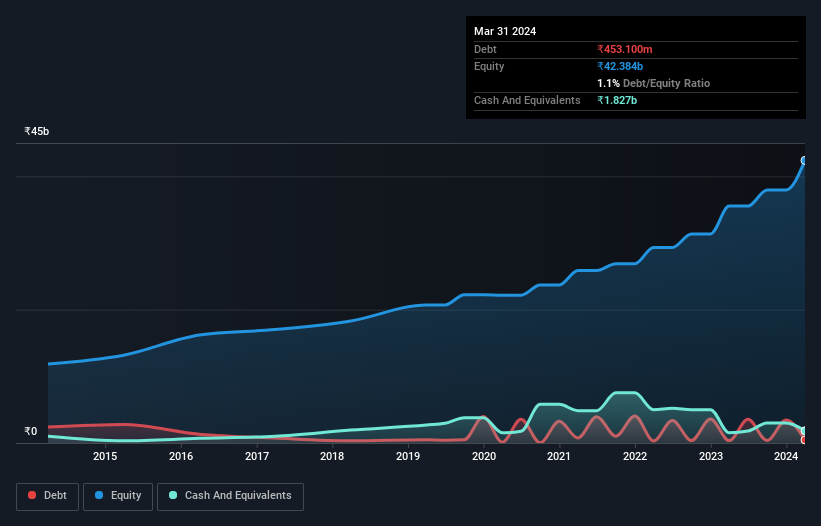Is Godfrey Phillips India (NSE:GODFRYPHLP) A Risky Investment?

The external fund manager backed by Berkshire Hathaway's Charlie Munger, Li Lu, makes no bones about it when he says 'The biggest investment risk is not the volatility of prices, but whether you will suffer a permanent loss of capital.' When we think about how risky a company is, we always like to look at its use of debt, since debt overload can lead to ruin. Importantly, Godfrey Phillips India Limited (NSE:GODFRYPHLP) does carry debt. But should shareholders be worried about its use of debt?
When Is Debt A Problem?
Debt is a tool to help businesses grow, but if a business is incapable of paying off its lenders, then it exists at their mercy. Ultimately, if the company can't fulfill its legal obligations to repay debt, shareholders could walk away with nothing. While that is not too common, we often do see indebted companies permanently diluting shareholders because lenders force them to raise capital at a distressed price. Of course, the upside of debt is that it often represents cheap capital, especially when it replaces dilution in a company with the ability to reinvest at high rates of return. The first step when considering a company's debt levels is to consider its cash and debt together.
Check out our latest analysis for Godfrey Phillips India
How Much Debt Does Godfrey Phillips India Carry?
As you can see below, at the end of March 2024, Godfrey Phillips India had ₹453.1m of debt, up from ₹358.5m a year ago. Click the image for more detail. But on the other hand it also has ₹1.83b in cash, leading to a ₹1.37b net cash position.

How Healthy Is Godfrey Phillips India's Balance Sheet?
According to the last reported balance sheet, Godfrey Phillips India had liabilities of ₹12.1b due within 12 months, and liabilities of ₹3.91b due beyond 12 months. Offsetting these obligations, it had cash of ₹1.83b as well as receivables valued at ₹1.75b due within 12 months. So its liabilities total ₹12.5b more than the combination of its cash and short-term receivables.
Of course, Godfrey Phillips India has a market capitalization of ₹190.0b, so these liabilities are probably manageable. But there are sufficient liabilities that we would certainly recommend shareholders continue to monitor the balance sheet, going forward. While it does have liabilities worth noting, Godfrey Phillips India also has more cash than debt, so we're pretty confident it can manage its debt safely.
Also good is that Godfrey Phillips India grew its EBIT at 12% over the last year, further increasing its ability to manage debt. The balance sheet is clearly the area to focus on when you are analysing debt. But it is future earnings, more than anything, that will determine Godfrey Phillips India's ability to maintain a healthy balance sheet going forward. So if you want to see what the professionals think, you might find this free report on analyst profit forecasts to be interesting.
But our final consideration is also important, because a company cannot pay debt with paper profits; it needs cold hard cash. While Godfrey Phillips India has net cash on its balance sheet, it's still worth taking a look at its ability to convert earnings before interest and tax (EBIT) to free cash flow, to help us understand how quickly it is building (or eroding) that cash balance. During the last three years, Godfrey Phillips India produced sturdy free cash flow equating to 69% of its EBIT, about what we'd expect. This free cash flow puts the company in a good position to pay down debt, when appropriate.
Summing Up
We could understand if investors are concerned about Godfrey Phillips India's liabilities, but we can be reassured by the fact it has has net cash of ₹1.37b. The cherry on top was that in converted 69% of that EBIT to free cash flow, bringing in ₹1.9b. So we don't think Godfrey Phillips India's use of debt is risky. There's no doubt that we learn most about debt from the balance sheet. But ultimately, every company can contain risks that exist outside of the balance sheet. To that end, you should be aware of the 2 warning signs we've spotted with Godfrey Phillips India .
Of course, if you're the type of investor who prefers buying stocks without the burden of debt, then don't hesitate to discover our exclusive list of net cash growth stocks, today.
New: Manage All Your Stock Portfolios in One Place
We've created the ultimate portfolio companion for stock investors, and it's free.
• Connect an unlimited number of Portfolios and see your total in one currency
• Be alerted to new Warning Signs or Risks via email or mobile
• Track the Fair Value of your stocks
Have feedback on this article? Concerned about the content? Get in touch with us directly. Alternatively, email editorial-team (at) simplywallst.com.
This article by Simply Wall St is general in nature. We provide commentary based on historical data and analyst forecasts only using an unbiased methodology and our articles are not intended to be financial advice. It does not constitute a recommendation to buy or sell any stock, and does not take account of your objectives, or your financial situation. We aim to bring you long-term focused analysis driven by fundamental data. Note that our analysis may not factor in the latest price-sensitive company announcements or qualitative material. Simply Wall St has no position in any stocks mentioned.
About NSEI:GODFRYPHLP
Godfrey Phillips India
Manufactures and sells cigarettes, chewing products, and tobacco products primarily in India and internationally.
High growth potential with solid track record and pays a dividend.
Market Insights
Community Narratives



